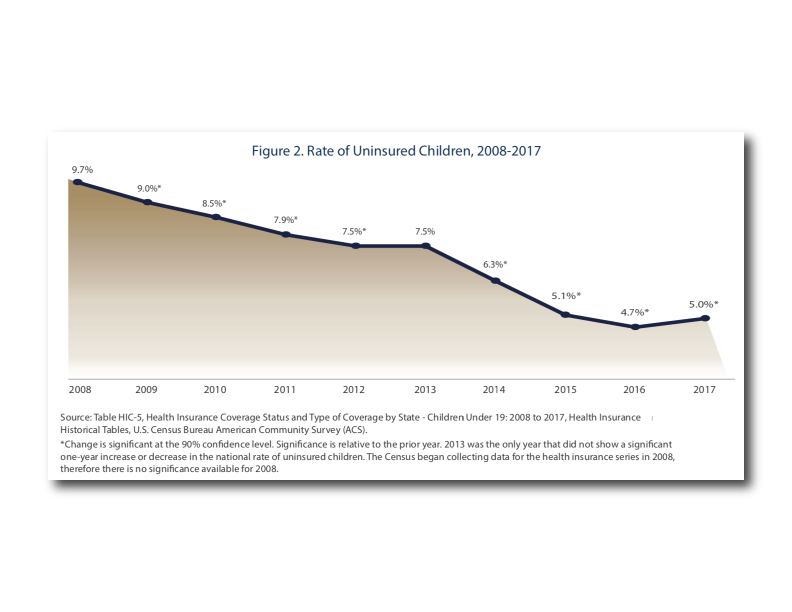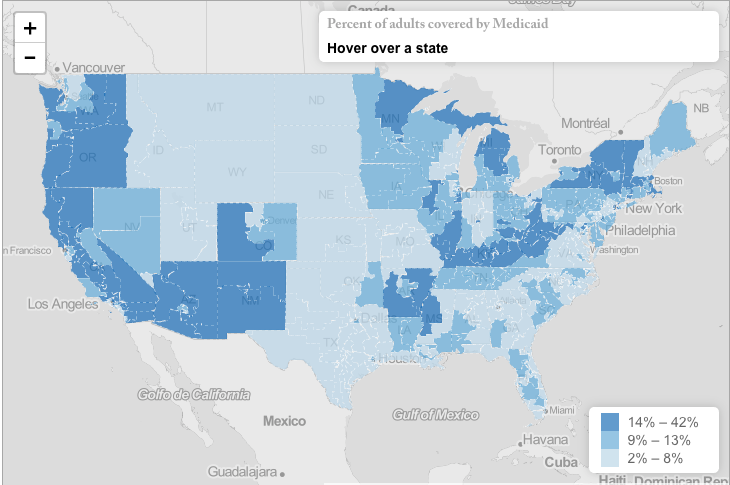Maryland
-
Medicaid’s Role in Small Towns and Rural Areas
Key Findings Background One-fifth of people in the United States live in areas that are classified as non-urban. Residents of rural areas and small towns face additional challenges accessing needed health services compared to residents of metro areas for a variety of reasons including acute provider shortages, limited connectivity, and long distances to travel to…
-
State Medicaid and CHIP Snapshots, 2023
The Georgetown University Center for Children and Families (CCF) and the American Academy of Pediatrics (AAP) created factsheets underscoring the importance of Medicaid in providing coverage for children in all 50 states and the District of Columbia. Sources available here. Previous snapshots can be found here (2019), here (2018) and here (2017). Check out more interactive…
-
2016 Maps
The interactive maps and data for 2016 provide information on the percent of adults and children covered by Medicaid and/or CHIP.You can embed these maps on your website by selecting a state on the left then copying the embed code on the right side of the map and pasting it into a post on your…
-
Nation’s Progress on Children’s Health Coverage Reverses Course
Introduction For the first time since comparable data was first collected in 2008, the nation’s steady progress in reducing the number of children without health insurance reversed course. The number of uninsured children under age 19 nationwide increased by an estimated 276,000 to about 3.9 million (3,925,000) in 2017, according to newly-available data from the…
-
State Medicaid and CHIP Snapshots, 2018
The Georgetown University Center for Children and Families (CCF) and the American Academy of Pediatrics (AAP) created factsheets underscoring the importance of Medicaid in providing coverage for children in all 51 states (including the District of Columbia). Sources are available here. Previous snapshots can be found here.
-
New GAO Report on Medicaid Waiver Evaluations Identifies Many Shortcomings
Earlier this week, the GAO released a new report that looks closely at Section 1115 Medicaid demonstration evaluations. The states examined are Arizona, Arkansas, California, Indiana, Kansas, Maryland, Massachusetts, and New York. The report was requested by Republican Members of Congress from the committees of jurisdiction. The report uncovered a number of problems including that…
-
Nationwide Rate of Uninsured Children Reaches Historic Low
Nationwide 95.5 percent of children had health insurance in 2016, up from 95.2 percent the previous year—and up from 92.9 percent in 2013, the year before the ACA was fully implemented. While relatively few children rely on the ACA’s Marketplace for insurance, many gained coverage in Medicaid or CHIP when their parents signed up for…
-
Section 1115 Medicaid Waiver Comments
Georgetown University’s Center for Children and Families contributes an independent perspective to the public dialogue on the future of Medicaid through the lens of children and their families.
-
State CHIP Snapshots
The Role of CHIP in Children’s Coverage In 2016 the children’s health insurance coverage rate in the United States dropped to just above 95 percent, an impressive achievement. Key to this success is the Children’s Health Insurance Program, which provides coverage to children who do not qualify for Medicaid but whose families cannot otherwise afford…
-
INTERACTIVE MAPS: Children Covered by Medicaid and CHIP by county, state or congressional district.
These maps show how many children are covered by Medicaid in each county and congressional district. Visit these links to view the maps, and to download handouts on your state’s coverage data: Percent of Children Covered by Medicaid/CHIP (congressional district) Percent of Children Covered by Medicaid/CHIP (county) Visit CCF’s State Resource Center for state-level data on health…
-
Children’s Coverage on the Eve of the Affordable Care Act
Here’s a good news story on health coverage that the public is largely unaware of. The number of uninsured children continues to decline to historic lows – a remarkable accomplishment given the high childhood poverty rate and tough economic times. Yet a majority of Americans are unaware of this achievement. In a poll CCF commissioned…
-
Children’s Health Coverage on the Eve of the Affordable Care Act
Georgetown University Center for Children and Families researchers analyzed health insurance data from the Census Bureau’s annual American Community Survey to get a closer look at children’s coverage trends. On the eve of the implementation of the Affordable Care Act coverage expansions, the authors found important lessons from the success the U.S. has had in covering children. The number of uninsured…
-
Implementing the ACA’s Extension of Medicaid to Former Foster Youth
It should be one of the health reform law’s most straightforward provisions: young adults who were in foster care and enrolled in Medicaid at the age of 18 (or older in states that extend foster care beyond the 18th birthday) get Medicaid coverage until they turn 26. But a wrinkle developed when HHS released proposed…
-
Getting Into Gear for 2014: Findings from a 50-State Survey of Eligibility, Enrollment, Renewal, and Cost-Sharing Policies in Medicaid and CHIP, 2012-2013
As 2013 begins, implementation of the major provisions of the ACA, including its coverage expansions, is less than a year away. Following the Supreme Court ruling to uphold the ACA and the 2012 elections, efforts to prepare for 2014 are moving into high gear in many states. The majority of states are capitalizing on web-based…
-
23 States Receive CHIPRA Performance Bonuses for Removing Barriers and Enrolling Children in Health Coverage
Demonstrating that covering kids is still a very high priority across the nation, twenty-three states earned CHIPRA performance bonuses for improving access to children’s health coverage and successfully enrolling eligible children. The states will split a total of nearly $306 million. The 23 states include: Alabama, Alaska, Colorado, Connecticut, Georgia, Idaho, Illinois, Iowa, Kansas, Maryland, Michigan, Montana,…
-
Green Light Comes Early for Six Health Insurance Exchanges
By Sarah Dash, Georgetown University Center on Health Insurance Reform On Monday, December 10th, the Department of Health and Human Services granted conditional approval to six states seeking to establish state-based health insurance exchanges: Colorado, Connecticut, Maryland, Massachusetts, Oregon, and Washington. The decisions came earlier than the January 1, 2013, statutory deadline for HHS to…
-
Uninsured Children 2009-2011: Charting the Nation’s Progress
Georgetown University Center for Children and Families researchers analyzed health insurance data from the Census Bureau’s annual American Community Survey to get a closer look at children’s coverage trends. The authors found that the nation continues to make steady progress covering children, despite no reduction in the number of children living in poverty. A strong commitment to…
-
State Fact Sheets Highlight Importance of Medicaid Coverage for Children
By Ielnaz Kashefipour, American Academy of Pediatrics The American Academy of Pediatrics, in partnership with the Children’s Hospitals Association (formerly NACHRI), this week produced updated state-by-state fact sheets that explain the importance of the Medicaid program for children. These fact sheets are used in federal and state advocacy efforts to protect the Medicaid program from…
-
Fresh Insights into Strategies and Messages for Enrollment in Medicaid and the Exchange
The Robert Wood Johnson Foundation recently released new research to help states identify messages that will encourage enrollment in Medicaid in 2014 when minimum eligibility levels are expanded to 133% FPL. The research also explores issues relating to state Exchanges, including attitudes about enrolling and choosing health insurance online. It was conducted in three states:…
-
Medicaid Coverage for Parents under the Affordable Care Act – State Fact Sheets
This issue brief presents national estimates of the number and characteristics of uninsured parents who would be eligible for Medicaid in 2014 according to whether they have child who is currently enrolled in Medicaid/CHIP coverage or an uninsured child who is eligible for Medicaid/CHIP but not enrolled. State-specific data are also provided on the ten…










